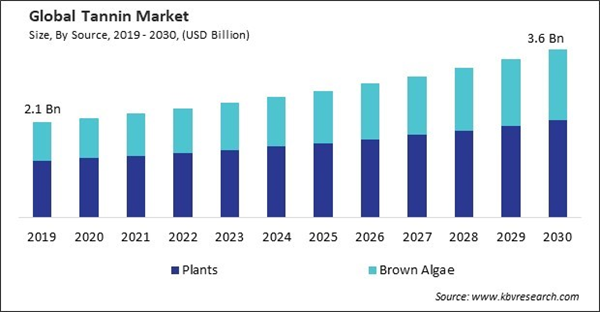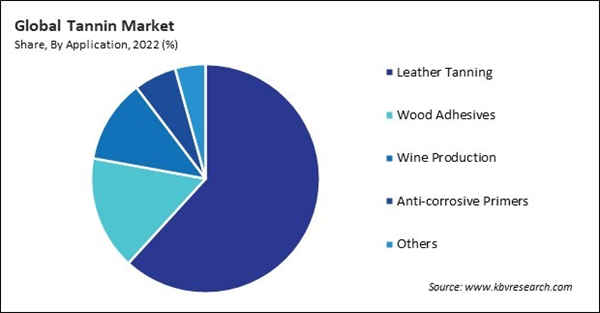The Global Tannin Market size is expected to reach $3.6 billion by 2030, rising at a market growth of 5.6% CAGR during the forecast period. In the year 2022, the market attained a volume of 2,594.03 Hundred Tonnes, experiencing a growth of 2.8% (2019-2022).
Europe is home to various industries that utilize tannins in various applications. Therefore, the Europe region captured $984.71 million revenue in the market in 2022. Also, Germany utilized 235.23 Hundred Tonnes in 2022. These include the leather industry for tanning hides, the wine industry for aging and flavor enhancement, the wood industry for adhesives and preservation, the pharmaceutical industry for medicinal purposes, and the food and beverage industry for flavoring and antioxidant properties.
There is a rising demand for goods created with natural ingredients as consumers’ concerns about their health and well-being develop. These are natural and nutritious additives that appeal to health-conscious consumers. They are produced from plant sources such as fruits, leaves, and tree bark. Therefore, rising preference for natural ingredients is driving the market’s growth.
Additionally, increased R&D efforts in the market led to the discovery of new extraction techniques, formulation methods, and applications for tannins. Innovative products and technologies developed through R&D initiatives expand the range of products available in the market, offering manufacturers and consumers more choices and opportunities for use. Thus, the growing research and development activities propel the market’s growth.
However, these are primarily extracted from various plant sources, including tree bark, fruits, and leaves. However, the availability of these plant materials is often subject to seasonal fluctuations, as plant growth cycles, environmental conditions, and harvest seasons impact the quantity and quality of raw materials available for its extraction. Hence, seasonal variability and sourcing challenges are hampering the market’s growth.
Europe is home to various industries that utilize tannins in various applications. Therefore, the Europe region captured $984.71 million revenue in the market in 2022. Also, Germany utilized 235.23 Hundred Tonnes in 2022. These include the leather industry for tanning hides, the wine industry for aging and flavor enhancement, the wood industry for adhesives and preservation, the pharmaceutical industry for medicinal purposes, and the food and beverage industry for flavoring and antioxidant properties.
There is a rising demand for goods created with natural ingredients as consumers’ concerns about their health and well-being develop. These are natural and nutritious additives that appeal to health-conscious consumers. They are produced from plant sources such as fruits, leaves, and tree bark. Therefore, rising preference for natural ingredients is driving the market’s growth.
Additionally, increased R&D efforts in the market led to the discovery of new extraction techniques, formulation methods, and applications for tannins. Innovative products and technologies developed through R&D initiatives expand the range of products available in the market, offering manufacturers and consumers more choices and opportunities for use. Thus, the growing research and development activities propel the market’s growth.
However, these are primarily extracted from various plant sources, including tree bark, fruits, and leaves. However, the availability of these plant materials is often subject to seasonal fluctuations, as plant growth cycles, environmental conditions, and harvest seasons impact the quantity and quality of raw materials available for its extraction. Hence, seasonal variability and sourcing challenges are hampering the market’s growth.
By Application Analysis
Based on application, the market is categorized into leather tanning, wine production, wood adhesives, anti-corrosive primers, and others. In 2022, the leather tanning segment registered 61.8% revenue share in the market. These are crucial agents in the leather tanning process. They chemically bind to collagen fibers in animal hides, transforming them into durable and flexible leather.By Source Analysis
Based on source, the market is bifurcated into plants and brown algae. In 2022, the plants segment garnered 59.4% revenue share in the market. Plants are a readily available source of tannins. They can be sourced from various parts of plants, such as bark, leaves, and fruits, which are often byproducts of other industries like agriculture and forestry.By Product Analysis
On the basis of product, the market is segmented into hydrolysable, non-hydrolysable, and phlorotannin. In 2022, the non-hydrolysable segment attained 30.1% revenue share in the market. Non-hydrolysable tannins, also known as condensed tannins or proanthocyanidins, are more stable than hydrolysable tannins.By Regional Analysis
Region-wise, the market is analyzed across North America, Europe, Asia Pacific, and LAMEA. In 2022, the Asia Pacific region generated 24.3% revenue share in the market. There is a growing awareness among consumers in the Asia-Pacific region about the benefits of natural and sustainable products.List of Key Companies Profiled
- Tannin Corporation
- Ajinomoto Co., Inc.
- Esseco S.r.l
- UCL Company (Pty) Ltd
- LAFFORT
- W.Ulrich GmbH
- TANIN d.d. Sevnica.
- Silvateam S.p.a.
- Indena S.p.A.
- Sisco Research Laboratories Pvt. Ltd.
Market Report Segmentation
By Source (Volume, Hundred Tonnes, USD Billion, 2019-2030)- Plants
- Brown Algae
- Hydrolysable
- Non-hydrolysable
- Phlorotannin
- Leather Tanning
- Wood Adhesives
- Wine Production
- Anti-corrosive Primers
- Others
- North America
- US
- Canada
- Mexico
- Rest of North America
- Europe
- Germany
- UK
- France
- Russia
- Spain
- Italy
- Rest of Europe
- Asia Pacific
- China
- Japan
- India
- South Korea
- Australia
- Malaysia
- Rest of Asia Pacific
- LAMEA
- Brazil
- Argentina
- UAE
- Saudi Arabia
- South Africa
- Nigeria
- Rest of LAMEA
Table of Contents
Chapter 1. Market Scope & Methodology
Chapter 2. Market at a Glance
Chapter 3. Market Overview
Chapter 4. Global Tannin Market by Source
Chapter 5. Global Tannin Market by Product
Chapter 6. Global Tannin Market by Application
Chapter 7. Global Tannin Market by Region
Chapter 8. Company Profiles
Companies Mentioned
- Tannin Corporation
- Ajinomoto Co., Inc.
- Esseco S.r.l
- UCL Company (Pty) Ltd
- LAFFORT
- W. Ulrich GmbH
- TANIN d.d. Sevnica.
- Silvateam S.p.a.
- Indena S.p.A.
- Sisco Research Laboratories Pvt. Ltd.
Methodology

LOADING...










